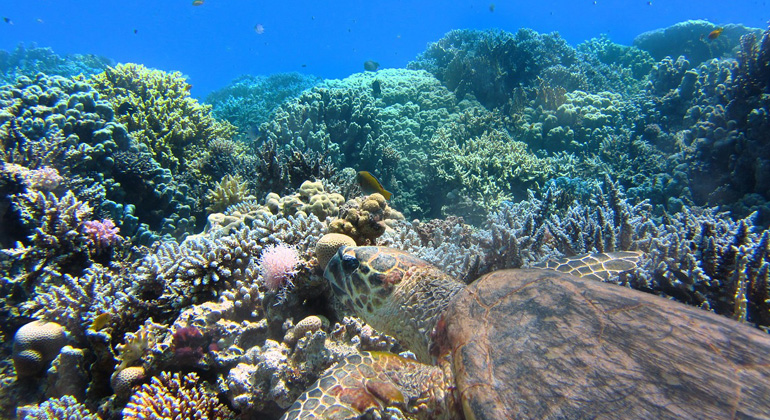Science Advances „Living evidence of a fossil survival strategy raises hope for warming-affected corals“
Climate change is affecting reef-building corals worldwide, with little hope for recovery.
However, coral fossils hint at the existence of environmental stress–triggered survival strategies unreported in extant colonial corals. We document the living evidence and long-term ecological role of such a survival strategy in which isolated polyps from coral colonies affected by warming adopt a transitory resistance phase, in turn expressing a high recovery capacity in dead colony areas.
Such processes have been described in fossil corals as rejuvenescence but were previously unknown in extant reef-builder corals. Our results based on 16 years of monitoring show the significance of this process for unexpected recoveries of coral colonies severely affected by warming. These findings provide a link between rejuvenescence in fossil and extant corals and reveal that beyond adaptation and acclimatization processes, modern scleractinian corals show yet undiscovered and highly effective survival strategies that help them withstand and recover from rapid environmental changes.
Corals are subjected to climate change–related impacts worldwide, with overwhelming evidence of mass mortalities affecting vast geographical areas in tropical and temperate seas. Although several studies have indicated that repeated exposure to increased water temperature can influence resistance in corals , there is high uncertainty regarding potential adaptive responses, and such responses either cannot be identified by the available long-term data or might be masked by the severity of the impacts. Searching for clues in the fossil record has previously provided crucial information for understanding the range of responses of coral reefs to climate change.
Survival strategies, hypothetically triggered by adverse environmental conditions, have been reported in fossil corals but remain undiscovered and thus unstudied in extant colonial corals. Polyp contraction or rejuvenescence is a frequently reported process in fossil corals (mainly Rugosa) and is defined as the action of a polyp leading to a reduction in its dimensions by leaving part of some skeletal structures in a calix outside its new external wall. Rejuvenescence and its ecological implications have never been described in modern scleractinian colonial corals, which are currently widely and intensively exposed to environmental degradation and climate change–related impacts.
Gaining knowledge of the occurrence of this survival strategy and its role in population recovery will allow clarification of the resistance processes in these emblematic ecosystems in response to current and past environmental changes.
Using 16 years of monitoring data from a permanent transect, we report the discovery of rejuvenescence as a warming-driven survival strategy in a temperate zooxanthellate reef builder, the Mediterranean scleractinian Cladocora caespitosa. This species is considered as a relict reef builder and a missing link to both the tropical reefs and the reefal ecosystems that occurred in the Mediterranean Sea before the end of the Messinian. However, large bioconstructions by this coral, which are frequent in the fossil record, have become extremely rare in the modern Mediterranean Sea.
One of the few sites still harboring large C. caespitosa colonies and patch reefs is located in a semi-enclosed bay in the Columbretes Islands Marine Reserve [northwestern (NW) Mediterranean Sea, Spain]. These corals have been uninterruptedly monitored since 2002, allowing quantification of the impact of recurrent warming-induced mortalities caused by a rapid polyp necrosis process without previous bleaching. The intensity and frequency of the mortalities, the slow dynamics of the species [i.e., slow growth and low recruitment rates], and the lack of evidence of potential acclimatization or adaptation processes predict a discouraging scenario for C. caespitosa, which is classified as an endangered species on the International Union for Conservation of Nature (IUCN) Red List.








